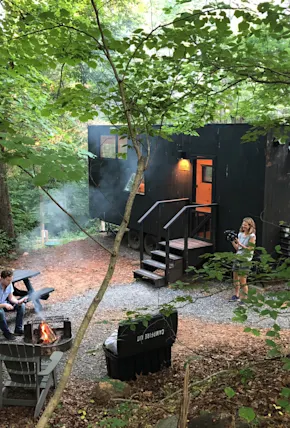The Different Types of Sauna Heaters
Sauna lovers know that heat is what defines a sauna, and the different sauna types are characterized by how and what type of heat is used to create the best type of sauna experience for you. To further understand how heat plays a role in the three main types of saunas, and to know which is best for you, here's a breakdown of the four different types of sauna heaters.
Wood Burning Stove
Wood burning saunas are a popular choice for those who want an all-natural sauna experience, outdoors. In comparison to the other heater types, wood fired saunas take longer to heat up, but create a soothing ambient heat and rich aroma that's worth the wait (the same can be said for wood fired hot tubs). Typically used in dry saunas, they require installing a chimney for ventilation, but other than that, are fairly low-cost and low-maintenance.
Electric Sauna Heaters
Electric saunas can be installed indoors or outside and relay on an electric sauna heater that heats up quickly and allows for much better temperature control than wood burning saunas. Electric heaters don't use up that much energy, so the operating cost stays fairly low, and must be installed a licensed electrician—something I talk about in my backyard sauna build. The biggest draw of electric saunas is getting to choose your desired temperature, and because you aren't waiting on a fire to build heat, more sauna time.
Infrared Sauna Heaters
These high-tech heaters harness the spectrum of far and near infrared wavelengths to generate heat that warms the body instead of the air around you. Infrared saunas have become increasingly desirable for the health benefits that don't just promote muscle recovery through sweating, but healing on a deeper level.
Since far infrared wavelengths have the most potential for healing, far infrared saunas are a popular choice for infrared sauna users. This, combined with the lower temperature, makes it the perfect sauna for someone who wants a gentler sauna experience. As an added bonus, the infrared sauna is a versatile option for a home sauna, because it can be installed indoors or outside.

Author Katherine Englishman with her backyard sauna
Indoor Sauna or Outdoor Sauna?
Depending on your available space, budget, and personal preference, home saunas can be installed both indoors or outside. Many companies sell sauna kits—like Redwood Outdoors, the maker of my outdoor mini-cube sauna—which arrived as precut pieces with all hardware included shipped directly to you, designed to be assembled in one day or less. Another option is to hire a professional to build a custom home sauna, or even DIY.
Speaking from personal experience, the amount of space will probably be the deciding factor here, but to help guide you in the right direction, below are some key considerations to help you choose indoor or outdoor sauna.
Indoor Sauna Considerations
Space - To install an indoor sauna, whether it's pre-fab or custom-built, you'll need the right amount of space for your sauna, including clearance for the door to open.
Ventilation and drainage - It is essential to make sure your space can properly ventilate heat and drain moisture (especially in a steam room!) when deciding between indoor or outdoor. Otherwise, mold and mildew will quickly accumulate and cause issues in the long term.
Vapor barrier and flooring - Talk to a professional to see if your indoor space has a vapor barrier to shield the rest of your home from the sauna's moist heat. Additionally, check to make sure your sauna either comes with flooring or needs to be installed directly on existing flooring, and whether or not it's compatible with the heat and humidity.
Electric hookups - Before buying, find out the voltage required from the heater and factor in any additional components such as lighting, sound, and digital controls, and check that your existing electric system can handle the amount.
Luckily, indoor saunas are pretty versatile. Some good options for enjoying a sauna session in the comfort of your own home include an infrared sauna, electric saunas, steam sauna, and even accessories like sauna blankets!












